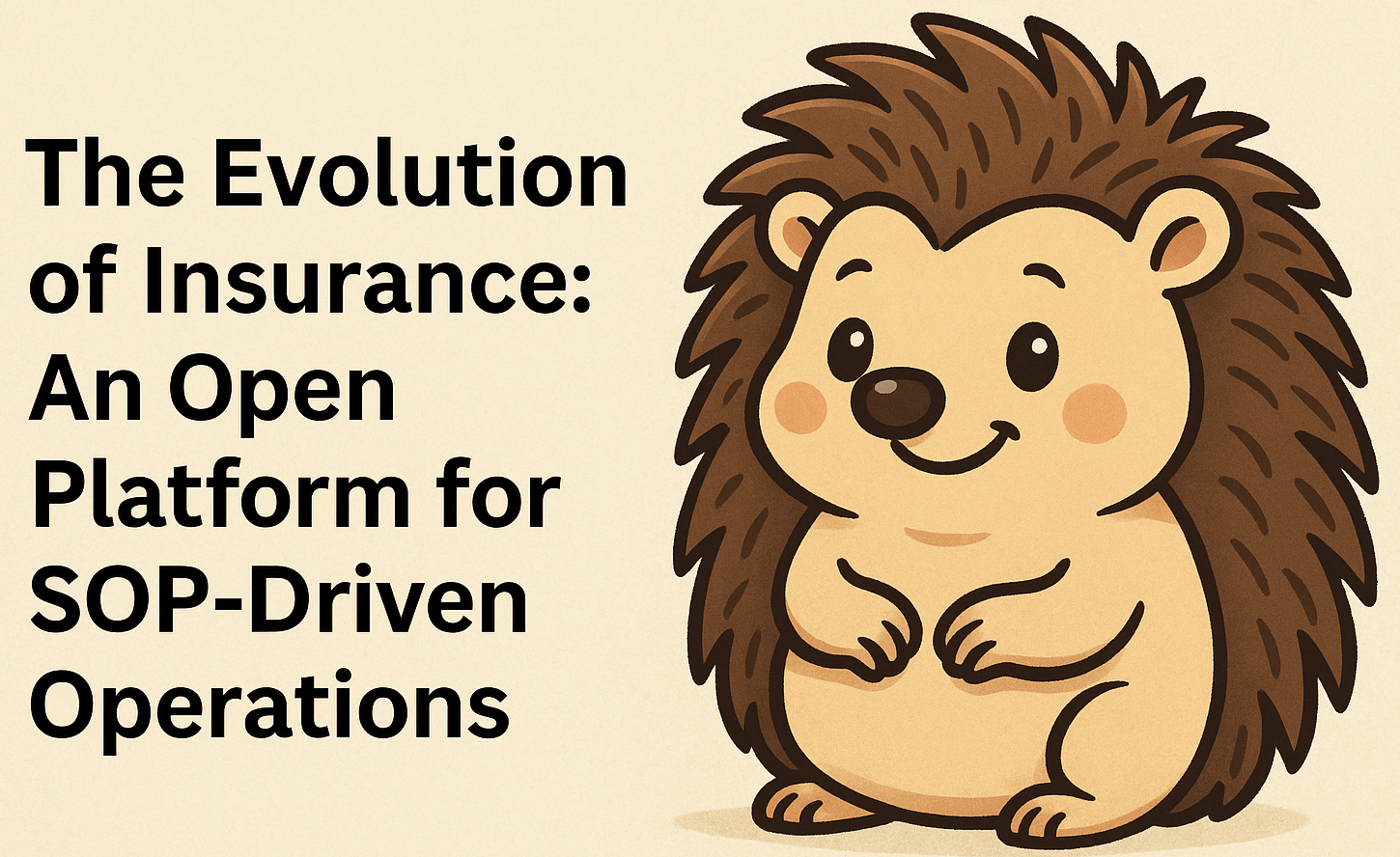ILS part 2 - Different Types of ILS

Hi there! Junixy the tech-loving hedgehog back for the ultimate deep dive into the ILS family! Last time we talked about how ILS connects insurance companies with investors, but today we're going to explore ALL the different flavours of ILS! Don’t worry if you find some of the terminology used confusing, its a lot to take onboard if you are new to this space, I have added a simple description of the terminology at the end.
Let's meet our cast of characters.
We've got Cat Bonds (the superstar), Industry Loss Warranties (the team player), Collateralized Reinsurance (the custom tailor), Sidecars (the perfect partner), Mortality/Longevity Bonds (the life specialists), and Parametric ILS (the speed demon). Each one has its own special way of helping manage risk and protecting against disasters!
Catastrophe Bonds (Cat Bonds)
Let's start with the superstar of the ILS world! Cat bonds are financial instruments that help insurance companies handle those really big, scary events like hurricanes, earthquakes, or floods. Think of them as a special type of loan where investors might not get their money back if a big disaster happens. The money they invest acts like a safety net for insurance companies. The term "catastrophe" here refers to these major natural disasters, and the "bond" part is because it's structured like a loan with regular interest payments.
How They Work
- Structure: A (re)insurer (known as the sponsor) creates a special purpose vehicle (SPV) that issues bonds to investors. The investor proceeds are placed in a collateral trust, typically invested in highly rated short-term securities.
- Triggers: If a specified catastrophic event (e.g., hurricane, earthquake) reaches certain parameters (the “trigger”), the SPV uses some or all of the collateral to pay the sponsor’s claims, reducing or eliminating principal repayment to investors.
- Investor Returns: If no triggering event occurs, investors receive periodic coupon payments plus the return of their principal at maturity. If the event occurs, investors forfeit part (or all) of their principal, which is used to pay the sponsor’s losses.
When They Are Used
- High-Severity, Low-Frequency Risks: Commonly used for natural catastrophes (hurricanes, earthquakes, windstorms), where large losses can occur but are relatively infrequent.
- Capacity Enhancement: Sponsors issue cat bonds to increase their capacity for large losses or to diversify how they pay for potential catastrophe claims.
- Diversification for Investors: Cat bonds attract pension funds, hedge funds, and other investors seeking returns uncorrelated with general economic or market risks.
Industry Loss Warranties (ILWs)
These clever tools look at the bigger picture! Instead of focusing on one insurance company's losses, ILWs are triggered by how badly the whole insurance industry gets hit by an event. The term "warranty" here is a bit misleading - it's really more like a promise to pay if things get really bad for everyone. An "industry loss" refers to the total amount of money the entire insurance industry has to pay out for a particular event.
How They Work
- Structure: An ILW is a reinsurance or derivative contract that pays out based on the total industry-wide loss from a specific event (or series of events), rather than the sponsor’s own losses.
- Triggers: The trigger is usually an industry loss index (e.g., PCS (Property Claim Services) estimates in the United States). Once the industry loss exceeds a certain threshold, the ILW pays out to the buyer.
- Coverage Basis: Because payouts are determined by industry losses rather than a single company’s losses, ILWs reduce moral hazard and are simpler to administer.
When They Are Used
- Market-Wide Events: Especially helpful when a sponsor wants coverage for large-scale catastrophes that affect the entire industry.
- Lower Transaction Costs: ILWs are often more cost-effective to set up than custom reinsurance, though the sponsor bears a “basis risk” if its losses do not align exactly with industry losses.
- Filling Gaps Quickly: ILWs are sometimes used to quickly fill capacity gaps in a sponsor’s catastrophe program.
Collateralized Reinsurance
Think of this as custom-designed protection with money upfront! "Collateralized" means all the money needed to pay potential claims is locked up in advance - no crossing fingers and hoping it's there when needed! "Reinsurance" is just insurance for insurance companies (yes, they need insurance too!). This combination means you get flexible, custom protection that's fully backed by real money.
How They Work
- Structure: In collateralized reinsurance, a special purpose vehicle (or a dedicated fund) provides reinsurance coverage directly to a sponsor. The capital provided is fully collateralized for the term of the contract.
- Collateral Arrangement: Investor funds are placed in a collateral trust to ensure payment of claims if triggered.
- Return to Investors: Investors earn a premium (effectively similar to reinsurance premiums) and may also receive returns on the collateral, depending on how it is invested. If no triggering event occurs, investors get back their principal.
When They Are Used
- Customized Coverage: Sponsors often seek collateralized reinsurance for tailored protection on specific portfolios or risks.
- Less Liquid: Collateralized reinsurance is usually less liquid than cat bonds because these are private contracts without a secondary trading market.
- Flexible Structures: Ideal for sponsors needing customized coverage terms that might not be easily securitized in a cat bond.
Sidecars
No, we're not talking about motorcycles! In the insurance world, a sidecar is like having a business partner who shares both your fortunes and your troubles. They get a percentage of your insurance premiums, but also have to pay the same percentage of any losses. The term comes from the way these vehicles "ride alongside" the main insurance company.
How They Work
- Structure: A sidecar is a vehicle set up by (re)insurers to accept a portion of their underwriting risk on a quota-share basis. Investors fund the sidecar, and in exchange, receive a proportionate share of premiums and bear a proportionate share of losses.
- Quota Share Arrangement: The sponsoring insurer cedes a set percentage of policies (premiums and losses) to the sidecar, aligning the sponsor’s interests with investors’.
- Return to Investors: Investors get a share of underwriting profit if the ceded business is profitable; otherwise, they absorb their share of the losses.
When They Are Used
- Capacity Expansion: If a (re)insurer sees profitable growth opportunities or needs to quickly bolster capacity after major catastrophes, a sidecar can provide fresh capital without diluting the sponsor’s core balance sheet.
- Shorter Lifespan: Sidecars are often set up for limited time periods (e.g., one to three years) to address specific market conditions.
- Targeted Portfolios: Typically focused on property catastrophe or specialty lines that are attractive to investors seeking higher yields with risk diversification.
Mortality/Longevity Bonds
These fascinating bonds deal with the ultimate uncertainties - life and death! Mortality bonds protect against too many people dying too quickly (think pandemic risk), while longevity bonds protect against people living longer than expected (great for everyone except pension funds!). These terms are pretty straightforward - mortality refers to death rates, and longevity refers to how long people live.
How They Work
- Structure: Similar to cat bonds, but the risk transferred is related to deviations in mortality or longevity rates rather than property catastrophe events.
- Triggers: Triggered by higher-than-expected mortality (e.g., pandemic risk) or longer-than-expected life spans (longevity risk). If actual rates exceed a predefined threshold, investors may lose part of their principal.
- Investor Returns: Investors earn coupon payments as long as the mortality/longevity experience stays within expected ranges.
When They Are Used
- Life Insurance and Pension Risks: Used by life insurers and pension funds to hedge against spikes in mortality (pandemic) or rising longevity (annuity obligations).
- Demographic-Based Risks: These structures may reference a mortality index (e.g., based on national or regional mortality statistics).
- Non-Correlation: Attracts investors seeking alternatives to natural catastrophe risk and non-correlation with equity and credit markets.
Parametric ILS
The speed demon of the ILS world! "Parametric" means these products pay out based on specific, measurable parameters - like wind speed for hurricanes or magnitude for earthquakes. No need to wait for loss adjusters or complex calculations. If the measurement hits the trigger point, the money flows!
(Note: Parametric triggers can apply to cat bonds, ILWs, or other ILS forms, but are worth highlighting separately because they represent a different approach to measuring loss.)
How They Work
- Structure: A parametric ILS pays out when a specific parameter (e.g., hurricane wind speed at landfall, earthquake magnitude, or rainfall amount) reaches or exceeds a threshold. It does not rely on actual claims data from the sponsor.
- Speed of Payout: Because payouts depend on easily verifiable event data (e.g., measured by weather stations or seismic sensors), sponsors can receive funds more quickly than with indemnity-based triggers.
- Basis Risk: The sponsor could suffer significant losses if the parameter threshold is not met or differs from the actual loss location/intensity.
When They Are Used
- Rapid Payout Needs: Parametric structures are especially useful for governments, corporations, or insurers wanting immediate liquidity after a disaster (e.g., governments of hurricane-prone countries).
- Data Availability: Works best when event parameters can be reliably and transparently measured.
- Simplicity and Transparency: Reduces potential disputes over claims adjustment because payouts are predetermined by the trigger measurement.
Let's do a super-quick lightning round of who's who in our ILS zoo:
· Cat Bonds: The classic superstar! Perfect for those big natural disaster moments
· ILWs: Our team player that watches the whole industry's scoreboard
· Collateralized Reinsurance: The custom tailor who makes everything fit just right
· Sidecars: Your perfect business partner who shares everything (good and bad!)
· Mortality/Longevity Bonds: Our life and death experts keeping tabs on the population
· Parametric ILS: The speed demon who pays out faster than a hedgehog can roll into a ball!
But here's the really cool part, friends! All these awesome tools do one super important thing: they connect the massive global money markets with the insurance world! This means:
- Insurance prices stay more stable (yay for your wallet!)
- More insurance available for everyone (protection for all!)
- Investors get something different to invest in (variety is the spice of life!)
Thanks for joining me on this wild ride through the ILS universe! Remember, whether you're protected against hurricanes, earthquakes, or even pandemics, there's probably and ILS out there protecting you in some way! Stay curious, stay protected, and catch you next time! Your friendly neighbourhood insurance-loving hedgehog, signing off
Terminology.
Is your head spinning from all these fancy insurance terms? Don't worry - even hedgehogs needed a glossary when they first started! Let's break down some of these brain-twisting terms into normal hedgehog-speak!
Bond
- What It Is: A bond is like a loan from investors to a company, government, or other organization (the “issuer”). In return, the issuer promises to pay interest (a “coupon”) at set intervals and return the original amount (the “principal”) when the bond “matures.”
- Plain English Example: Think of it as lending money to your neighbor and agreeing that they’ll pay you regular interest until a certain date, at which point they’ll give you back the full amount you lent.
Coupon
- What It Is: In the world of bonds (including Cat Bonds), the “coupon” is just another word for the interest payment bondholders receive.
- Plain English Example: Think of a bank paying you interest on a savings account. Here, instead of a bank, the bond issuer (the insurance company’s special vehicle) pays you interest for investing your money with them.
Principal
- What It Is: The original amount of money you invest or loan out (in this case, the money you use to buy a bond).
- Plain English Example: If you deposit $1,000 into a bond, that $1,000 is your principal.
Trigger
- What It Is: A specific condition or event that, if it happens, causes the bond (or other ILS product) to pay out to the sponsor (the insurance company).
- Plain English Example: Imagine a car insurance policy that only pays out if you have an accident. The “accident” is the trigger. In Cat Bonds, a “Category 5 hurricane making landfall” can be a trigger.
Collateral
- What It Is: Money or assets set aside to ensure that if something bad happens (like a natural disaster), there are guaranteed funds to pay out claims.
- Plain English Example: Think of it like putting rent money in a deposit. If the trigger event occurs, that deposit gets used to cover the losses.
Collateral Trust / Special Purpose Vehicle (SPV)
- What It Is: An SPV is a legal entity created specifically to hold investors’ money (the collateral) and manage the bond. It keeps the money separate from the insurance company’s other finances.
- Plain English Example: Picture a “lockbox” that holds all the invested funds. That lockbox can only be opened under the contract rules (e.g., if disaster strikes).
Premium (in Reinsurance)
- What It Is: In regular insurance, a premium is what you pay monthly or yearly to be covered. In reinsurance or ILS deals, the insurer pays a premium to the ILS provider or reinsurer.
- Plain English Example: The same way you pay a monthly premium to your car insurer, an insurance company pays a premium to a reinsurer or ILS vehicle to ensure they can handle really big disasters.
Basis Risk
- What It Is: This is the risk that the payout from the ILS might not perfectly match the actual losses. It can occur if triggers are based on industry-wide losses or parametric data (e.g., wind speed) instead of the insurer’s specific claims.
- Plain English Example: Suppose you take out “hail insurance” for your strawberry farm tied to local weather station data. If hail ravages your farm but the weather station doesn’t register large-enough hail, you might not get paid, even though you have real damage. That mismatch is basis risk.
Underwriting
- What It Is: The process of evaluating and pricing risk. In insurance, underwriters decide how much coverage to offer and at what cost (premium).
- Plain English Example: It’s like sizing up the risk: if you lend your friend $100, you check if they’re reliable. In insurance, underwriters figure out how likely it is they’ll have to pay for a future claim.
Mortality & Longevity
- What They Are: Mortality is the rate at which people in a certain group are expected to pass away; longevity is how long people live compared to expectations.
- Plain English Example: “Mortality” bonds pay out if more people die than expected (e.g., during a pandemic). “Longevity” bonds pay out if people live longer than expected (e.g., your grandpa’s pension fund might need protection if everyone outlives the standard predictions).
Parametric
- What It Is: A parametric trigger relies on a specific, measurable event (like wind speed or earthquake magnitude) rather than actual insurance claims data.
- Plain English Example: If a hurricane’s wind speeds reach 120 mph as measured by official sensors, payment is made automatically—no need to file detailed damage claims first.


